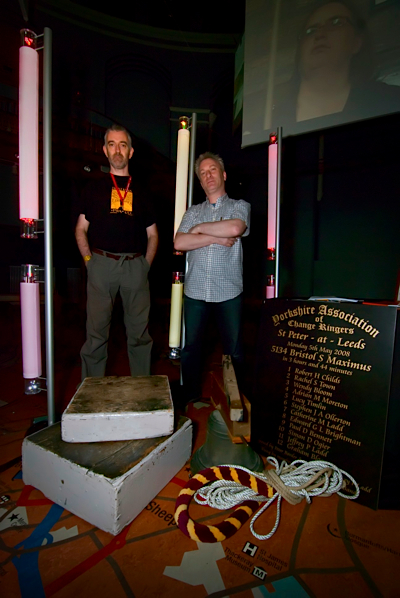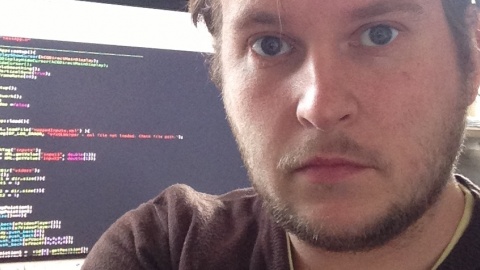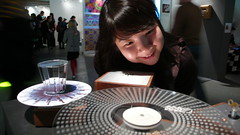About Us
Monomatic
was initiated in 2007 as a collaboration, experimental playground and halfway house between the work of Anthony Rowe of squidsoup – art, research and play in creative interaction design using sound, physical and virtual space – and Lewis Sykes then of The Sancho Plan – a progressive audiovisual collective who explore the realtime interaction between music and video. Monomatic has since evolved and the current line up now includes Nick Rothwell a.k.a Cassiel – a composer, performer, software architect, programmer and sound designer and most recently Ben Lycett – a visual artist, filmmaker, technologist and programmer.
Monomatic explore sound and interaction
We create physical works that investigate rich and sonorous musical traditions, which we attempt to describe, develop conceptually and creatively and then re-stage in new environments.
We work with technology but aim for transparency – keeping the subject rather than our custom-coded software architectures and hand-fabricated mechanical and electronic workings to the fore.
We’re drawn to elegant design and endeavour to recapture a sense of craft and workmanship in the pieces we produce.
In all our work we aim for simplicity, playfulness, humour and above all agency – “action or intervention, esp. such as to produce a particular effect”.
Through several of our recent works we’ve become increasingly fascinated with the art of campanology – or bell ringing.

Nick Rothwell (left) and Lewis Sykes (right) with PEAL at Leeds City Museum, Sep ’09
Nick Rothwell
is a composer, performer, software architect, programmer and sound designer. He has built performance systems for projects with Ballett Frankfurt, Vienna Volksoper and Braunarts, and has worked at STEIM (Amsterdam), CAMAC (Paris) and ZKM (Karlsruhe). He has composed soundtracks for choreographers Aydin Teker (Istanbul) and Richard Siegal (Laban Centre), and has performed with Laurie Booth (Dance Umbrella, New Territories), and at the Different Skies Festival (Arcosanti, Arizona), the ICA, and the Science Museum’s Dana Centre.
Recent projects include performance systems for Quartet (with director Margie Medlin), interactive video for Troop at the Southbank (with choreographer Jane Turner), surround sound for the media gallery at The Public, interactive installations for Sonic Arts Network and TECHNE (Istanbul), a planetarium gig in Colorado, and a Portable Choreographic Artefact in collaboration with Ricochet Dance Productions. He is currently working in software for Random Dance (Sadler’s Wells), in sound for body>data>space alongside CIANT (Prague) and Kibla (Slovenia), and in audiovisuals for the current Future of Sound tour.
Cassiel: www.cassiel.com
Works: www.cassiel.com/space/Projects
Compositions: soundcloud.com/cassiel
Lewis Sykes
is a musician, interaction designer, digital media producer and curator and qualified Youth & Community Worker specialising in the Arts. A veteran bass player of the underground dub-dance scene of the 90s he performed and recorded with acts such as Emperor Sly, Original Hi-Fi and Radical Dance Faction and was a partner in the respected underground dance label Zip Dog Records.
He refocused and honed his interests in mixed media through an MA in Hypermedia Studies at the University of Westminster in 2000 and continues to refine his fusion of music, visualisation and technology through more recent creative collaborations – such as musician with the progressive audiovisual collective The Sancho Plan.
Lewis is Director of Cybersonica – an annual celebration of music, sound art and technology (now in its ninth year) – and between 2002-2007 was Coordinator of the independent digital arts agency Cybersalon, founding Artists in Residence at the Science Museum’s Dana Centre.
Lewis has recently started a Practice as Research PhD at MIRIAD, Manchester Metropolitan University exploring artistic representation of modal wave phenomenon.
Phd: www.augmentedtonoscope.net
The Sancho Plan: www.thesanchoplan.com
Cybersonica: www.cybersonica.org
Blog: blog.lewissykes.info
Ben Lycett
is a visual artist, filmmaker, technologist and programmer whose work investigates the zones where art and science collide. His outputs range from interactive installations for museums and galleries, to immersive sound reactive performances in night clubs nationwide.
Ben’s background in visual arts started as a photographer in Newcastle. He worked for several large photographic studios, including Alex Tefer, Magenta Studio and North East Studio working on campaigns for clients such as the BBC, Peugeot and Halifax Building Society. He then was awarded a digital fellowship at Teeside University and won ‘most innovative project’ for his animation ‘Leo Fox’. After becoming more and more interested in the relationship between movement , light and the narrative of moving photographs he moved to Manchester to study film and specialised in directing and sound design gaining a 1st class degree at MMU in 2009. He started to work at 24 Design, making films and coding interactive for national galleries, including Manchester Art Gallery, Whitworth Art Gallery, Eureka, Shed Bristol, and the Barbican. Ben’s most recent interactives will be in the National Gallery for Modern Art in Edinburgh and the Museum of Science and Industry (MOSI) in Manchester.
Ben’s VJ-ing has taken him all over the UK underground music scene, and was a resident VJ at Meandyou, Bohemian Grove, Illuminate, Content and the Beat-Herder Festival. He also started to make his own software and hardware to help him perform his visual art live – including a video mixer and software to create an abstract, sound responsive 3d world.
Ben is currently a lecturer on the BA Creative Multimedia, Manchester Metropolitan University and ‘Coder-in-Residence’ for {CODE Creatives} – part of Designing our Futures, the AHRC funded, skills development programme aimed at postgraduate and early career researchers in the North West.
Influenced by artist/groups such as Theo Watson, Memo Aklin and Random International his main practice now revolves around code – using the C++ creative coding toolkit ‘Openframworks’ to generate video and openGL outputs via inputs from devices such as Microsoft’s XBox Kinect, the Arduino open-source micro-controller platform and the Leap Motion gestural controller.
Although the path from photographer to coder might seem a strange journey, to Ben it’s all just an extension of creating an image, be it through photography, film, sound design or software.

